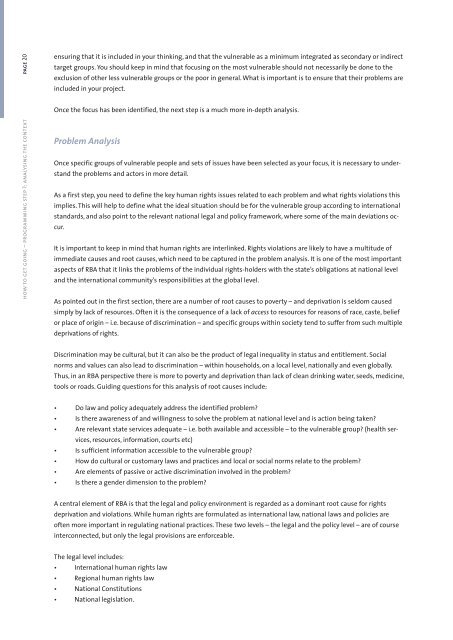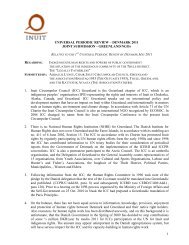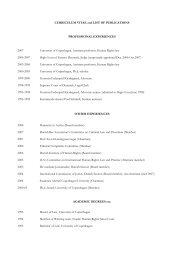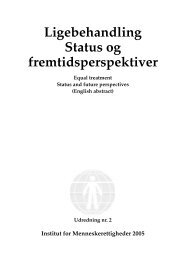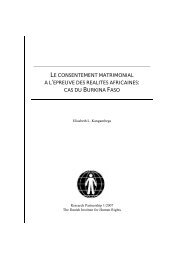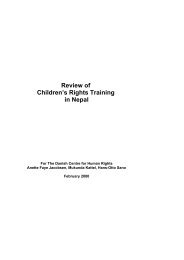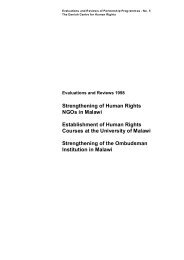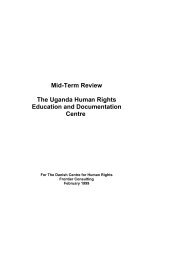applying a rights-based approach - Danish Institute for Human Rights
applying a rights-based approach - Danish Institute for Human Rights
applying a rights-based approach - Danish Institute for Human Rights
Create successful ePaper yourself
Turn your PDF publications into a flip-book with our unique Google optimized e-Paper software.
how to get going – programming step 1: analysing the context page 20<br />
ensuring that it is included in your thinking, and that the vulnerable as a minimum integrated as secondary or indirect<br />
target groups. You should keep in mind that focusing on the most vulnerable should not necessarily be done to the<br />
exclusion of other less vulnerable groups or the poor in general. What is important is to ensure that their problems are<br />
included in your project.<br />
Once the focus has been identified, the next step is a much more in-depth analysis.<br />
Problem Analysis<br />
Once specific groups of vulnerable people and sets of issues have been selected as your focus, it is necessary to understand<br />
the problems and actors in more detail.<br />
As a first step, you need to define the key human <strong>rights</strong> issues related to each problem and what <strong>rights</strong> violations this<br />
implies. This will help to define what the ideal situation should be <strong>for</strong> the vulnerable group according to international<br />
standards, and also point to the relevant national legal and policy framework, where some of the main deviations occur.<br />
It is important to keep in mind that human <strong>rights</strong> are interlinked. <strong>Rights</strong> violations are likely to have a multitude of<br />
immediate causes and root causes, which need to be captured in the problem analysis. It is one of the most important<br />
aspects of RBA that it links the problems of the individual <strong>rights</strong>-holders with the state’s obligations at national level<br />
and the international community’s responsibilities at the global level.<br />
As pointed out in the first section, there are a number of root causes to poverty – and deprivation is seldom caused<br />
simply by lack of resources. Often it is the consequence of a lack of access to resources <strong>for</strong> reasons of race, caste, belief<br />
or place of origin – i.e. because of discrimination – and specific groups within society tend to suffer from such multiple<br />
deprivations of <strong>rights</strong>.<br />
Discrimination may be cultural, but it can also be the product of legal inequality in status and entitlement. Social<br />
norms and values can also lead to discrimination – within households, on a local level, nationally and even globally.<br />
Thus, in an RBA perspective there is more to poverty and deprivation than lack of clean drinking water, seeds, medicine,<br />
tools or roads. Guiding questions <strong>for</strong> this analysis of root causes include:<br />
• Do law and policy adequately address the identified problem?<br />
• Is there awareness of and willingness to solve the problem at national level and is action being taken?<br />
• Are relevant state services adequate – i.e. both available and accessible – to the vulnerable group? (health services,<br />
resources, in<strong>for</strong>mation, courts etc)<br />
• Is sufficient in<strong>for</strong>mation accessible to the vulnerable group?<br />
• How do cultural or customary laws and practices and local or social norms relate to the problem?<br />
• Are elements of passive or active discrimination involved in the problem?<br />
• Is there a gender dimension to the problem?<br />
A central element of RBA is that the legal and policy environment is regarded as a dominant root cause <strong>for</strong> <strong>rights</strong><br />
deprivation and violations. While human <strong>rights</strong> are <strong>for</strong>mulated as international law, national laws and policies are<br />
often more important in regulating national practices. These two levels – the legal and the policy level – are of course<br />
interconnected, but only the legal provisions are en<strong>for</strong>ceable.<br />
The legal level includes:<br />
• International human <strong>rights</strong> law<br />
• Regional human <strong>rights</strong> law<br />
• National Constitutions<br />
• National legislation.


